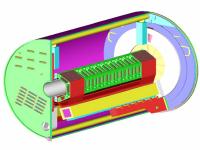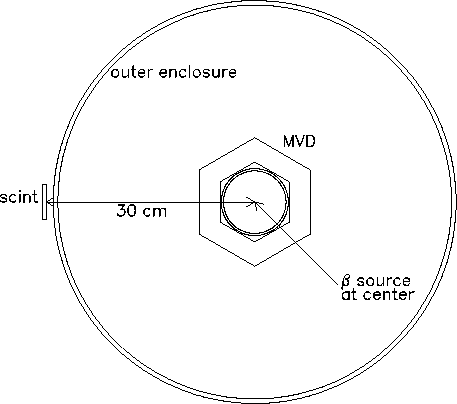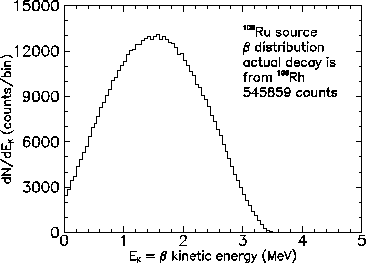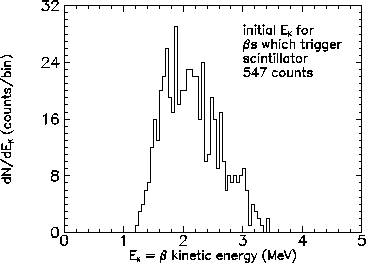
|

|

|

|
John Sullivan
PHENIX-MVD-99-3
Assume:
The assumed geometry is sketched below:
First, estimate the energy loss of electrons going through the MVD.
The material involved in the
pisa (geant based)
model of the MVD is:
Particles going through the rohacell cages could completely miss the
material in the cages, they could go through up to 2.5 cm of rohacell,
or anything in between. The following table summarizes the amount of
material in the MVD and the approximate energy loss in each material.
To start with, I had to create a more or less correct beta distribution.
Mine is not perfect, and should slightly overestimate the counting rate
because it produces too many higher energy beta's. Details are
are here.
A
pisa simulation of the MVD showed that a minimum energy of about 1 MeV was needed
go through all of the material and then
to trigger the scintillator in this model. The back of the envelope calculation
above gives an estimated average energy loss of 0.4 MeV in the
material. Combining this with the 0.5 MeV threshold required for the
scintillator gives a cutoff of 0.9 MeV -- in reasonable agreement.
For details on the pisa code used, click here.
In an effort to include material which should be in the model, but is not (e.g. glue, paralene),
a calculation with the density of rohacell increased by a factor of 4 was done. This
should increase the average amount of material by 315 mg/cm^2 -- more than doubling it.
This should be a significant overestimate.
It should increase the expected energy loss by about 0.63 MeV -- to about 1.5 MeV
when the scintillator's discriminator threshold is included. A calculation showed
a cutoff around 1.4 MeV -- again in reasonable agreement with expectations.
The following two plots show the initial kinetic energy
distribution of a betas in the simulation followed
by the initial kinetic energy distribution for those betas
which triggered the scintillator. This calculation assumed rohacell
had 4 times it true density (see above).
Next, I did a calculation with a source which isotropically omitted beta
particles. I counted the number of these electrons which trigger the
scintillator. This fraction was 547/545859.
Assume that the particles which generate the trigger all go through
a single Si wafer (an oversimplification, but useful for the estimates below).
There are 256 Si channels per wafer. To get N_hits hits per channel
in each of these channels, we would require about
N_decays = 256*545859*N_hits/547 = (255466+-10922)*N_hits beta decays.
If we want N_hits to be about 500 and we would like to do this in 10 minutes
(for example), this defines the activity of the source needed:
255466*500 decays/600 sec = 212888+-9102 decays/sec.
A micro-Curie is 3.7E4 decays/sec, so this
source strength would be 212888/3.7E4 = 5.75+-.25 microCurie .
In an
earlier estimate for the strength of a gamma source, I had estimated that
we would need about 2.65Curie -- about 460K times larger. This estimate had assumed
that there would be no trigger at all -- so the rate would need to be high enough
to get a significant hit rate in each strip of the MVD.

material
name
avg amount
(mg/cm^2)
max amount
(mg/cm^2)
dE/dx (mip)
(MeV/(gm/cm^2))
avg dE (mip)
(keV)
max dE (mip)
(keV)
aluminum 11 11 1.62 17 17
air 30 30 1.82 66 66
Si 70 140 1.66 70 140
cages 33 188 2.0 66 375
enclosure 72 72 2.0 144 144
cables 11 22 1.8 19 38
total
227
463
--
382
780


John Sullivan
comments to: sullivan@lanl.gov
updated 22-Jan-1999